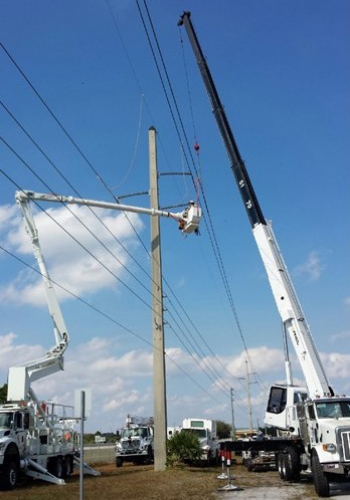No other type of equipment may be quite as synonymous with utility work as boom trucks.
They’re indispensable in electrical transmission and distribution applications: setting poles, hoisting crossarms or insulators, positioning transformers and serving as an aerial work platform for personnel during line construction and maintenance. Boom trucks are equally at home on oil and gas jobsites, as well.
So what sets them apart? Boom trucks combine on-road mobility with an incredible array of options for reach, lift capacity, controls, attachments and other features. As utilities and contractors look to get even more from these versatile machines, manufacturers are finding new ways to deliver.
Greater mobility to get from job to job
One of the biggest advantages of a boom truck is that it’s mounted on a conventional, over-the-road truck chassis (such as a Freightliner, Kenworth or Peterbilt). While all-terrain cranes offer greater capacity, local weight or size restrictions on transport can prove challenging.
“Boom trucks are known for being highly mobile,” says Randy Robertson, director of sales and marketing for Manitex. “When properly configured, they can travel at highway speed within legal load limits. In the utility world, efficiency is everything: work one tower, finish it up, rig down, move on to the next one and get that stick back in the air as quickly as you can.”
“For operators, boom trucks are more accessible,” says Bob Ritter, product manager for National Crane. “They still need a commercial driver’s license. But they don’t need the same skill level that would be required for transporting a large, 500-ton all-terrain crane.”
“A standard truck chassis is also beneficial from the standpoint of service and support,” says Zak Hilliard, market manager for Altec. “With truck dealerships and repair shops throughout the country, taking care of regular chassis-related maintenance is simpler and more convenient. That helps make boom trucks more efficient from a cost standpoint.”
 Options to fit your jobsite needs
Options to fit your jobsite needs
One area where boom trucks really shine is in offering utilities and contractors virtually limitless options to meet their specific needs.
“Our goal is to provide the right tool for the job,” says Ritter. “Contractors need to answer a lot of questions going in. What’s my operating height? What’s the classification for the job? What’s the terrain like? What kind of aerial work am I going to do? That’s why we offer so many different options and configurations. Boom trucks can be customized in so many ways — from the truck chassis and engine to multiple boom lengths and more.”
“A boom truck gives customers a lot of flexibility,” says Robertson. “You can tailor it in terms of how you want it powered or how it needs to be configured as far as lift axles and suspension ratings to meet federal and local regulations. Some utilities want as much boom as they can get and still be able to legally travel on roadways. Others may want more outrigger penetration so the machine can lift itself up higher on rough terrain.”
“Working closely with customers to understand their unique needs allows us to match the best possible crane with the best truck in one system,” says Hilliard. “They’re not just buying a crane. We design the best solution, help source the chassis, and make sure they’re fully familiar with everything before it goes out in the field. You have to look at the whole package.”
Helping utility crews work safely
Operating cranes and working around power lines is dangerous work. That makes safety and training critical when using boom trucks.
“Nothing is more important than safety,” says Ritter. “Our investment in this area has been above and beyond. Safety first is part of our culture. It’s ingrained in everything we do — from the way we design and build equipment to the online and on-site training we offer through our dealer network.”
“Safety is paramount, not only in design and manufacture, but also in operation,” says Hilliard. “We engineer and build safety into every possible aspect of our products. Altec was one of the first manufacturers to introduce systems such as a Load Moment Indicator (LMI) and outrigger interlock, which prevents the crane from operating before the outriggers are deployed. We also offer several dual-rated boom trucks that meet both the ASME B30.5 mobile crane and ANSI A92.2 aerial lift standards.”
“Today all boom truck cranes feature advanced technology to help operators perform safe lift operations,” says Robertson. “Load monitoring and capacity alert systems are invaluable. Manitex also provides comprehensive training for dealers and their customers. We’ll arrange to have service techs go out and provide hands-on training with utility contractors, in addition to providing factory-training opportunities.”
More reach, more lift capacity
As utilities and contractors seek out more ways to prove the versatility of boom trucks, the drive for even greater capability and productivity continues.
“Innovation has grown exponentially the past 15 years,” says Ritter. “You’re seeing a lot of advancements in the area of chassis and suspension design. We’re bringing customers more features and flexibility, from transmission and engine choices to longer boom lengths and electronic monitoring.”
“Utility customers appreciate the smaller footprint of a boom truck, but want greater reach,” says Hilliard. “We’re looking at the design methodology of the crane itself — the boom, substructure and outriggers — to see where we can get more structurally efficient in terms of strength-to-weight ratio. Listening to customers helps us push the industry forward and make sure new products are a good solution.”
“Longer booms are definitely more of a trend,” says Robertson. “The more reach you can provide to a utility customer, the better. It expands what they can do on the job. They can put personnel in an aerial platform, then reconfigure the machine to do lift work on the same site, the same day.”
“One example of that innovation is the NBT60XL,” says Ritter. “On the utility side, it can reach the 200-foot platform height needed to work on the tallest transmission and distribution lines. And because at-height work is more about reach than load capacity, it features hydraulically removable counterweights. This gives contractors the ability to take only what they need to do the job, potentially eliminating the need for trip permits.”
“Working with Linewise, Manitex was the first to introduce a crane configured with a phase lifter — allowing crews to perform maintenance on a power line without having to take it out of service. The more ways we can help utilities improve productivity and safety, the better.”
Featured in this article:
Join thousands of industry peers who receive utility construction industry news and trends each week. Subscribe to The Utility Expo Newsletter.












